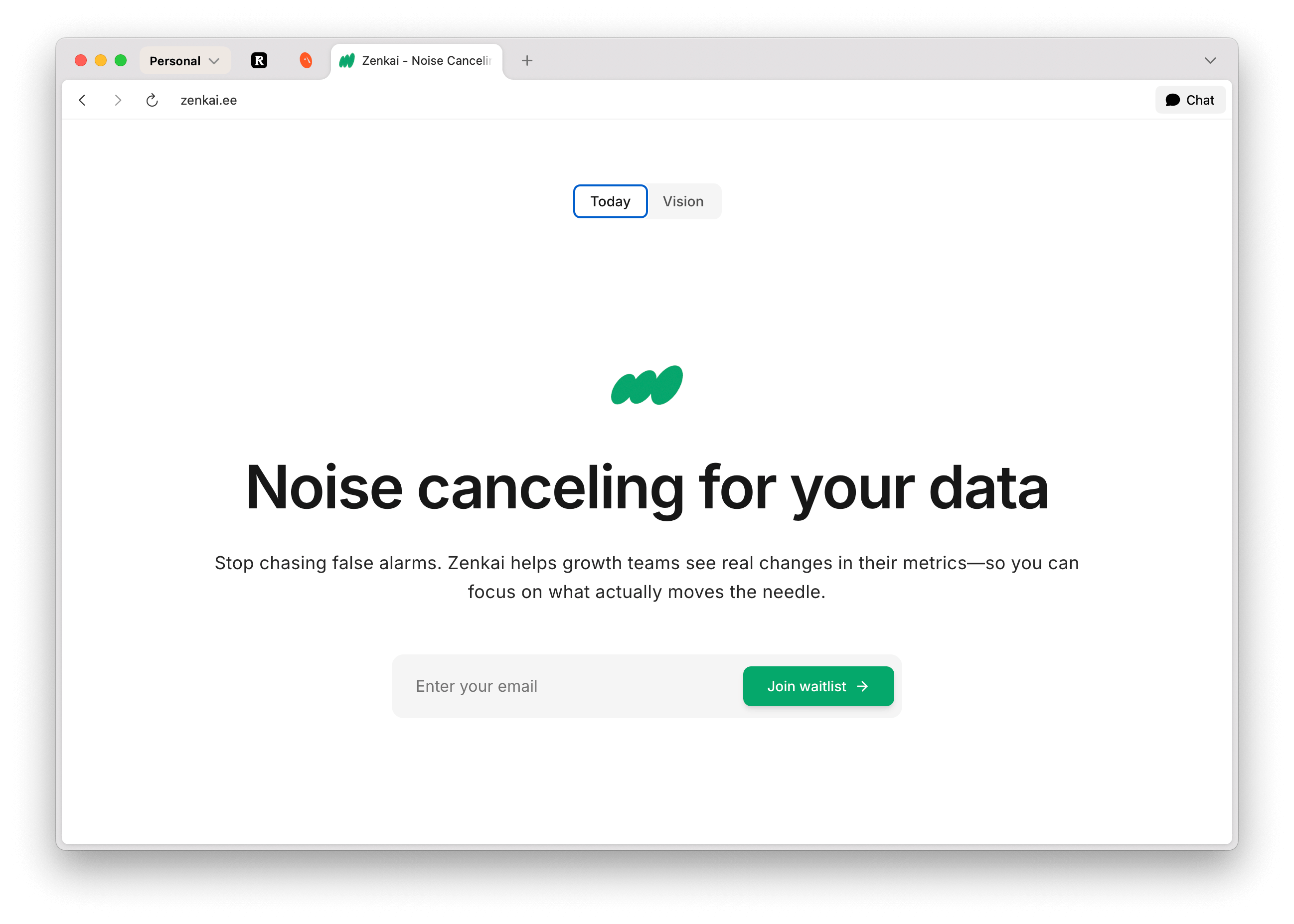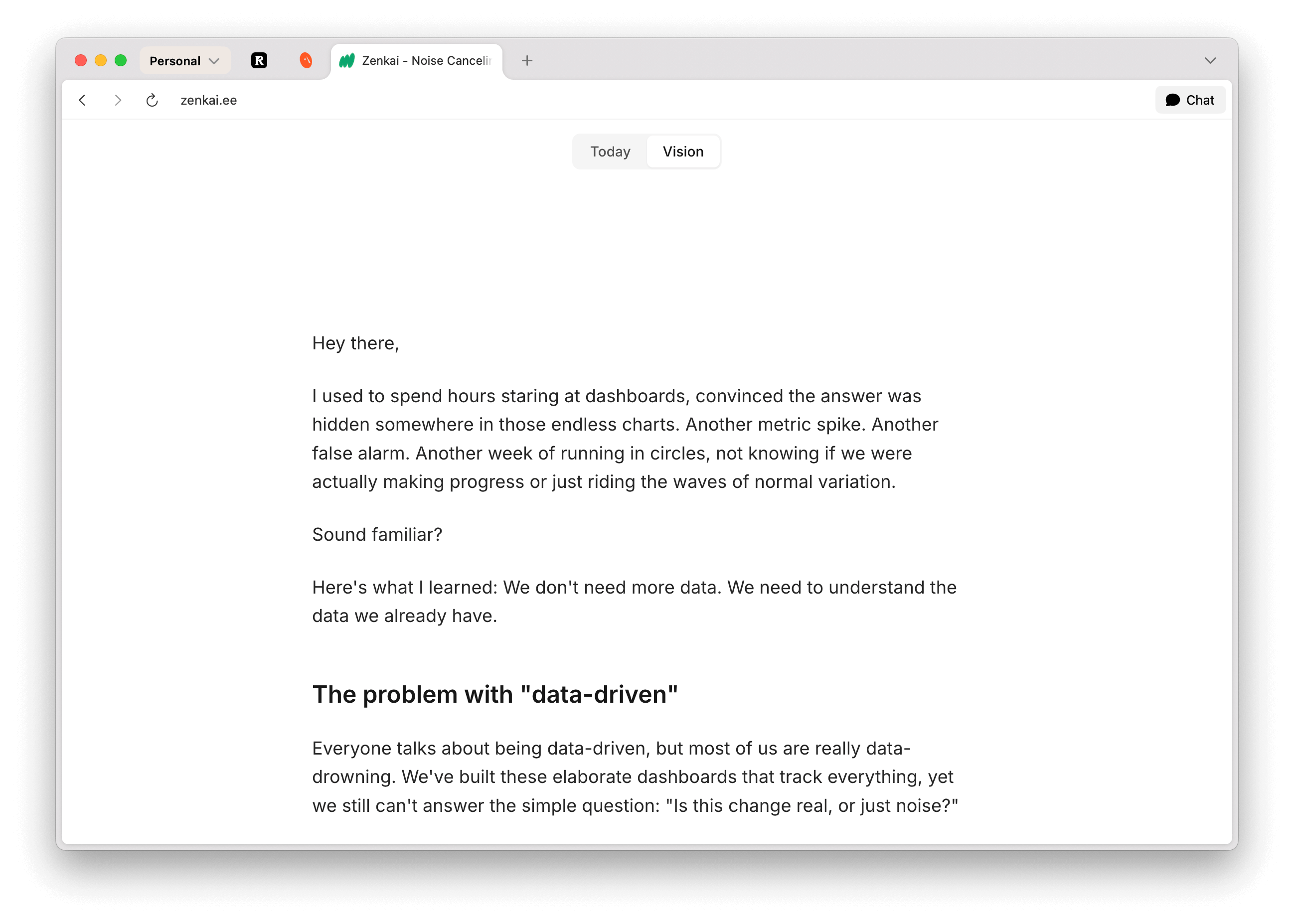
I spent most of this week circling around Zenkai’s value. I knew XmR charts were useful—I’d been sketching versions of this tool for years—but I couldn’t articulate why someone would care enough to use it.
The breakthrough came when I stopped thinking about XmR charts as a tool and started thinking about who I’m building for and what they care about.
People don’t want statistics. They want to stop panicking about their Monday morning dashboard reviews. They want to see if their experiments are working and how they could improve their job.
Finding the epicenter
The tension between scope and focus led me to write a vision document. While I have ambitions for where Zenkai could go—broader analytics, team workflows, decision frameworks—XmR charts are conceptually noval. Most people don’t know what they are, let alone why they’d need one.
So I made a deliberate choice: lead with immediate, tangible value on the homepage (“Today”), then reveal the bigger picture (“Vision”).

The product needs to earn the right to show its full potential.
This constraint forced to prototype the core interaction: upload data, see the chart, understand what matters. It’s still rough, but for the first time I can show someone the product instead of talking about it.
Plus it’s simple enough to demo in 30 seconds. Powerful enough that someone immediately grasps why they’d come back.
What I shipped
I got the landing page live on zenkai.ee and started collecting waitlist signups. The messaging is finally honest—it’s not about loving statistics, it’s about sleeping better on Sunday nights because you know Tuesday’s dip in conversions was probably just Tuesday being Tuesday.
Sharing the launch and messaging with the Lovable Shipped community and on social brought in a wave of feedback and validation.
It’s always nerve-wracking to put something out there, but the response confirmed that the core idea resonates.
The vibe coding discovery
Here’s what I didn’t know before building with AI: you become a better product manager by accident.
Since you have to explain everything to the AI through chat, you’re forced to think through what you’re building and why. I kept catching myself typing out features and then stopping because I realized I couldn’t explain in detail what I wanted to do. I had to take a moment to think again.
The other thing: be stupidly detailed in your prompts. More detailed than feels reasonable. When I went with specific copy, exact spacing requirements, and references to interactions I liked, suddenly the output matched what was in my head.
The AI won’t get annoyed if you micromanage every pixel.
What didn’t go to plan
Not everything worked out. I didn’t get as far as I wanted with onboarding flows or demo data import. The friction here is real: I want the first-touch experience to be magical, but the details and edge cases of onboarding are always trickier than they are in my head.
Community wisdom that stuck
Two community events this week put me in the right mindset to make progress with building Zenkai.
Chris Donnelly’s lecture hammered home a principle I keep thinking about: “First-time founders focus on product, second-time founders focus on distribution.”
His essential questions for idea validation—Who is this for? What problem does it solve? Why now?—were a forcing function for me to sharpen my own answers.
The fireside chat with Dani Grant and Claire Vo reminded me that you’re never “one more feature” away from product-market fit. People will use an imperfect product if it solves a problem.
That’s why I focussed on making the core value as clear and accessible as possible.
Next week’s focus
I want to open the doors: no registration, no friction, straight to the “aha!” moment with XmR charts.
The technical building isn’t the hard part. The hard part is making XmR charts feel like magic instead of math homework. I want someone with zero statistics background to upload their website conversion data and immediately understand which weeks are worth investigating.
My north star: craft a first-touch experience that’s not just clear, but a little bit magical—where the product tells its own story.
Honest reflection
I spent years waiting for the “right moment” to build this. If I’m being honest, it wasn’t just perfectionism—I was afraid of coding. The technical barrier felt insurmountable, so I kept sketching and planning instead of building.
The Lovable (and similar) changed that.
What used to require months of development I can now ship in days. The product I built this week isn’t polished, but it exists. People can use it. That’s everything.
In this early phase, learning is the only thing that matters. I don’t know who my customers are, what they actually need, or if they’ll care about any of this. The only way to find out is to put something real in their hands and see what happens.
The six-week program keeps me focused and moving forward. But honestly? You could move even faster. The constraint isn’t time—it’s having the courage to ship something imperfect and start the conversation.
Time to ship 🚢